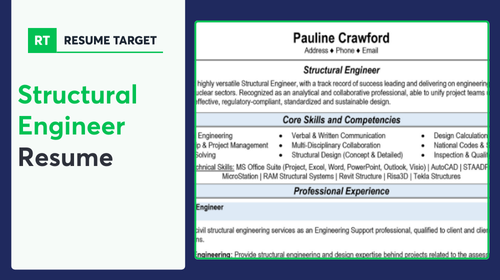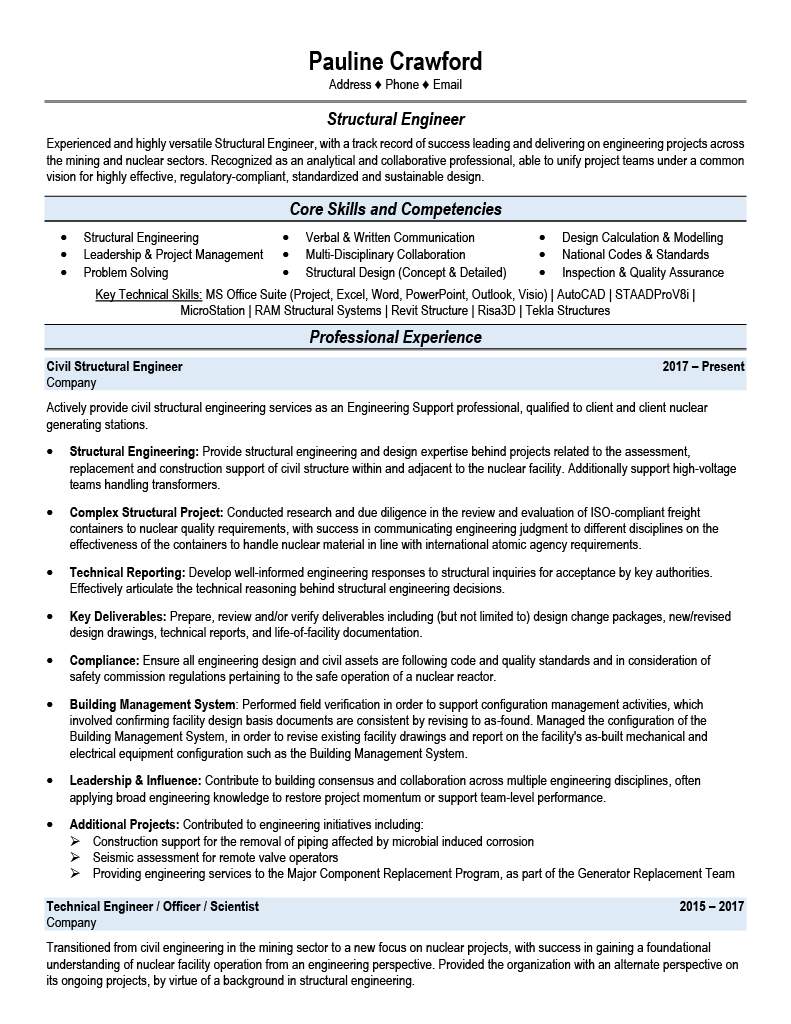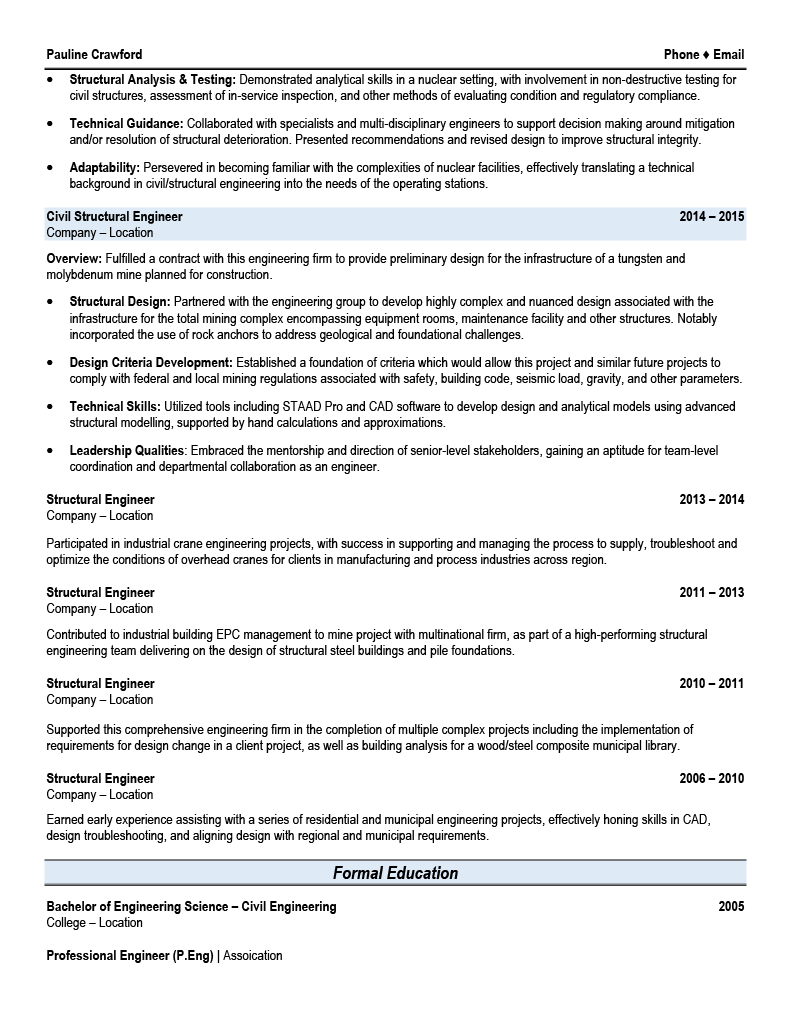

Complex engineering projects fill your portfolio, but explaining them on paper feels like building a bridge without blueprints. Your technical achievements deserve more than a list of calculations and project names.
Are you struggling to translate your engineering expertise into compelling resume content? You need a strategic approach that showcases both your technical mastery and your problem-solving impact on major construction projects.
Resume Target specializes in helping structural engineers transform technical jargon into powerful success stories. This guide will show you exactly how to build a resume that demonstrates your engineering excellence and lands more interviews.


Behind every skyscraper that pierces the clouds and every bridge that spans impossible distances, there's a structural engineer calculating precisely how to make these architectural marvels stand strong and safe - they're essentially the architects of structural integrity, ensuring that buildings can withstand everything from snow loads to earthquake forces.
As a structural engineer, you'll work closely with architects and contractors, using advanced mathematical modeling and engineering principles to design the intricate framework of buildings - think of yourself as creating the skeleton that gives life to architectural visions while keeping people safe.
Whether you're passionate about sustainable building design or dream of engineering the next iconic bridge, the path to becoming a structural engineer offers diverse opportunities for growth, from earning your professional license to potentially leading major infrastructure projects that will stand for generations.
Let's talk about what's exciting in the Structural Engineering field - your expertise in designing and analyzing buildings, bridges, and earthquake-resistant structures can lead to an incredibly rewarding career path with competitive compensation. And guess what? The field offers multiple specialization opportunities that can boost your earning potential even further.
Figures from: University of North Dakota Engineering
Start your structural engineering journey with hands-on project experience and advance to leadership roles through professional certifications and specialized expertise. Your path can lead to managing major construction projects or consulting.
Beyond basic engineering knowledge, your career advancement depends on mastering advanced design software, developing project management expertise, and building strong leadership capabilities while maintaining cutting-edge technical proficiency.
- Advanced structural analysis software proficiency - Building code expertise - Complex problem-solving abilities - Project management - Technical documentation - Construction methodology knowledge - Team leadership and communicationLaunch your structural engineering career by combining a bachelor's degree in civil or structural engineering with hands-on experience through internships, leading to professional licensure and exciting opportunities in building design.
Your path to becoming a successful structural engineer requires mastering both technical and interpersonal skills, with clear communication abilities and project management capabilities being essential foundations for career advancement.
Requirements from Teal HQ
From bustling construction hubs to infrastructure hotspots, structural engineering roles span coast to coast across major metros.
Figures from CEE Careers
Struggling to blueprint your structural engineer resume in a way that showcases your technical expertise, project achievements, and engineering capabilities as effectively as you design buildings and infrastructure? This comprehensive, section-by-section guide will help you construct a rock-solid resume that stands out to engineering firms and hiring managers.
As a structural engineer who excels at calculating loads and designing complex systems, you might find condensing your expertise into a few powerful sentences feels more challenging than analyzing a cantilever beam.
While you're skilled at translating technical specifications into buildable solutions, capturing your ability to balance safety requirements, innovative design approaches, and project management capabilities in a brief summary requires a different kind of precision - one that speaks directly to what hiring managers are seeking.
How would you describe your engineering philosophy and approach to structural design that sets you apart from other structural engineers?
Reason: This helps establish your professional identity and demonstrates your fundamental understanding of the field while highlighting your unique perspective on structural engineering principles.
What combination of technical expertise, design software proficiency, and building code knowledge best represents your value as a structural engineer?
Reason: This question helps you articulate your core technical competencies in a way that showcases your comprehensive understanding of the structural engineering field's key requirements.
How would you characterize your experience across different project types (commercial, residential, industrial) and your ability to collaborate with architects, contractors, and other stakeholders?
Reason: This helps frame your versatility and interpersonal abilities, which are crucial differentiators in structural engineering where project success depends heavily on cross-functional collaboration.
As a structural engineer, you need to showcase both your technical expertise in design and analysis alongside your practical project management abilities.
Your skills section should balance sophisticated engineering capabilities like structural modeling and analysis software proficiency with essential competencies such as building code compliance and construction site coordination.
Showcase your engineering expertise by organizing your experience into three powerful sections: a concise role overview that highlights your design scope, quantifiable achievements that demonstrate your structural solutions, and core responsibilities that emphasize your technical leadership and project management capabilities.
Many structural engineers struggle to translate complex technical projects and calculations into clear, compelling achievements that resonate with hiring managers. Transform your engineering accomplishments into powerful success stories by connecting your structural solutions to measurable improvements in safety, efficiency, and cost reduction.
The responsibilities section demonstrates how Structural Engineers ensure building safety and integrity through technical expertise and innovative design solutions. Your duties should showcase both technical capabilities and your ability to collaborate with architects, contractors, and stakeholders while highlighting your impact on project success.
Your educational background and professional certifications are crucial proof points of your expertise in structural analysis and design. Lead with your highest engineering degree and most relevant professional licenses, especially your PE license and any specialized structural certifications that demonstrate your competency in building codes and structural systems.
Now that you've built a strong foundation for your resume using Resume Target's comprehensive guidelines, you're ready to take it to the next level.
While many structural engineers focus solely on customizing their cover letters, tailoring your resume for each position is equally crucial for showcasing your specific design expertise, project experience, and technical capabilities.
A customized structural engineering resume not only helps you navigate through ATS systems by incorporating role-specific keywords, but it also demonstrates to hiring managers how your unique combination of technical skills, building codes knowledge, and project management experience perfectly aligns with their requirements.
Ready to transform your resume into a powerful blueprint for success? Let's engineer your application to stand out from the competition!
Don't let a lack of professional experience hold you back from launching your career as a Structural Engineer!
Your engineering coursework, technical skills, and design projects can create a compelling story that showcases your potential to employers.
Focus on highlighting your engineering fundamentals, CAD/modeling proficiencies, and any hands-on design projects or internships you've completed.
For more guidance on crafting your technical resume, check out the Student Resume Writing Guide to ensure you're positioning yourself for success.
Your resume summary is your chance to showcase your engineering education, design projects, and technical capabilities that make you an ideal candidate for structural engineering roles.
Focus on highlighting your academic achievements, internship experiences, and any relevant software proficiencies that demonstrate your readiness to tackle real-world structural challenges.
"Detail-oriented and technically skilled Structural Engineer graduate with comprehensive academic training and internship experience in structural analysis and design. Proficient in AutoCAD, ETABS, and SAP2000, with hands-on experience in construction site monitoring and structural calculations through university projects. Demonstrated strong analytical abilities through successful completion of multiple design projects, including a award-winning senior capstone project. Seeking to leverage strong foundation in structural principles and emerging technologies to contribute to innovative building solutions."
Now's your chance to showcase the rigorous academic foundation that prepared you for structural engineering excellence - from advanced mathematics to specialized design courses!
Transform your educational background into compelling content by highlighting relevant coursework like "Advanced Structural Analysis"and describing hands-on projects where you used modeling software or conducted materials testing.
unavailableRelevant Coursework: Structural Analysis | Steel Design | Reinforced Concrete | Foundation Engineering | Structural Dynamics | Advanced Mechanics of Materials
Key Projects:
Multi-Story Building Design Project: Led structural analysis and design of a 12-story commercial building using industry-standard modeling software and building codes to ensure safety and efficiency.
Bridge Design Optimization Study: Collaborated with a four-person team to redesign an existing pedestrian bridge focusing on cost-effectiveness and sustainability.
Leverage your academic training, internship experiences, and technical proficiencies to create a compelling skills section that showcases your readiness to tackle structural engineering challenges while highlighting your knowledge of industry-standard tools and methodologies.
As an entry-level Structural Engineer, your foundation in these essential skills positions you well for a career in this growing field, where you'll have opportunities to contribute to increasingly complex and meaningful infrastructure projects.
When you're immersed in complex calculations and building specifications all day, it can feel impossible to translate your technical expertise into language that both hiring managers and ATS systems can understand.
At Resume Target, we specialize in engineering resumes and know exactly how to showcase your structural design achievements and technical capabilities in a way that resonates with industry leaders.
Our proven track record includes helping structural engineers land positions with top engineering firms by highlighting their unique combination of analytical skills and practical construction knowledge.
With major infrastructure projects on the horizon and increasing demand for qualified structural engineers, now is the perfect time to elevate your career prospects - let's craft your standout resume today.
Impress any hiring manager with our Engineering resume writing service. We work with all career levels and types of Engineering professionals.
Learn More → Engineering Resume Writing Services